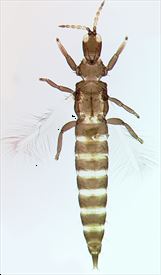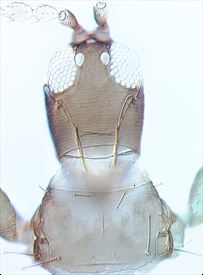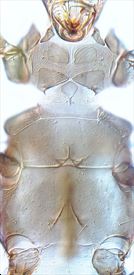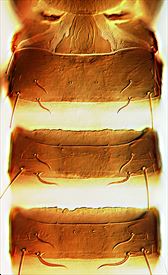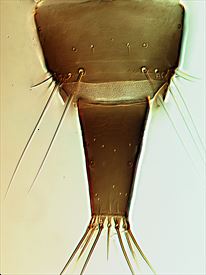Distinguishing features
Female fully winged. Body and legs dark brown, fore tarsi light brown; antennal segments III–IV yellow, V–VI yellow in basal half but light brown at apex; fore wing pale with extreme base shaded; major setae dark brown except on tergite IX. Antennae 8-segmented, segment III with 2 sense cones, IV with 4 sense cones. Head slightly longer than wide; postocular setae weakly capitate and about as long as width of compound eye, arising close to posterior margin of eye; maxillary stylets retracted to postocular setae, about half of head width apart with distinct maxillary bridge. Pronotum with 5 pairs of slender, capitate major setae. Prosternal basantra well developed; mesopresternum complete and boat-shaped but very narrow medially; metathoracic sternopleural sutures not developed. Fore tarsus with small tooth near apex. Fore wing constricted medially, with about 8 duplicated cilia; all 3 sub-basal setae capitate. Pelta triangular; tergites II–VII each with 2 pairs of sigmoid wing-retaining setae; tergite IX setae finely acute and as long as tube; tube shorter than head width.
Related species
The genus Haplothrips comprises 240 described species worldwide, of which only four are recorded from New Zealand, and none of these seems to be endemic. H. gowdeyi is not recorded from New Zealand, but is a potential immigrant. It belongs to a group of Haplothrips species in which antennal segment III bears two sense cones, and many of these species seem to be associated with the flowers of Asteraceae. Despite the structural differences, gowdeyi is easily confused with kurdjumovi when examined under low magnification due to the similar colour of the antennae.
Biological data
This species breeds within flowers, but whether it is always phytophagous or sometimes predatory is not clear. Adults and larvae have been collected from a wide range of flowers, including those of various Asteraceae and Poaceae, but there is no clear evidence of any particular host association.
Distribution data
Presumably from tropical Africa originally, as this is the only area from which males have been seen, H. gowdeyi is found widely around the world in tropical and subtropical countries. It is not yet recorded from New Zealand, but it is a potential invader as it is present on Norfolk Island (Mound & Wells, 2015).
Family name
PHLAEOTHRIPIDAE, PHLAEOTHRIPINAE
Species name
Haplothrips gowdeyi (Franklin)
Original name and synonyms
Anthothrips gowdeyi Franklin, 1908: 724
Anthothrips usitatus Bagnall, 1910: 695
Anthothrips variabilis Crawford DL, 1910: 166
Haplothrips karnyi Bagnall, 1913: 296
Haplothrips brevicollis Bagnall, 1913: 297
Haplothrips soror Schmutz, 1913: 1036
Haplothrips sororcula Schmutz, 1913: 1036
Anthothrips dozieri Watson, 1918: 71
Haplothrips mahensis Bagnall, 1921: 267
References
Hoddle MS, Mound LA, Paris DL (2012) Thrips of California 2012. CBIT Publishing, Queensland. http://keys.lucidcentral.org/keys/v3/thrips_of_california/
Thrips_of_California.html
Mound LA & Wells A (2015) Endemics and adventives: Thysanoptera (Insecta) Biodiversity of Norfolk, a tiny Pacific Island. Zootaxa 1020:183–210.

